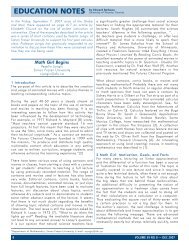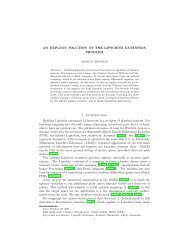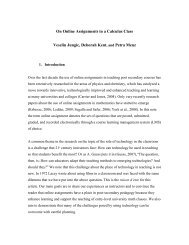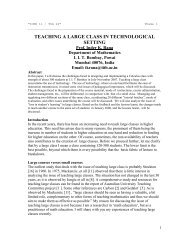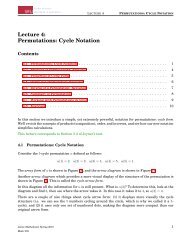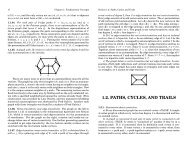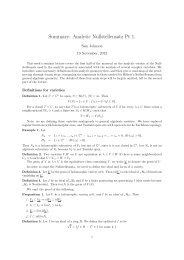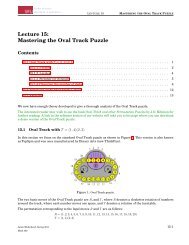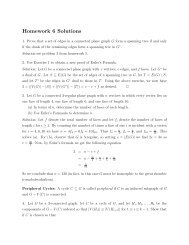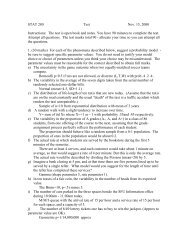Hw 1 Solutions - People.stat.sfu.ca
Hw 1 Solutions - People.stat.sfu.ca
Hw 1 Solutions - People.stat.sfu.ca
You also want an ePaper? Increase the reach of your titles
YUMPU automatically turns print PDFs into web optimized ePapers that Google loves.
1 Chapter 1: Fundamental Concepts Section 1.1: What Is a Graph? 2<br />
1.FUNDAMENTAL CONCEPTS<br />
1.1. WHAT IS A GRAPH?<br />
1.1.1. Complete bipartite graphs and complete graphs. The complete bipartite<br />
graph Km,n is a complete graph if and only if m = n = 1 or {m, n} = {1, 0}.<br />
1.1.2. Adjacency matrices and incidence matrices for a 3-vertex path.<br />
<br />
0 1 1 0 1 0 0 0 1<br />
1 0 0 1 0 1 0 0 1<br />
1 0 0 0 1 0 1 1 0<br />
<br />
1<br />
<br />
1 1<br />
<br />
1 1<br />
<br />
0 0<br />
<br />
1 1<br />
<br />
0 0<br />
<br />
1<br />
1 0 0 1 1 1 1 1 0 1 1 0<br />
0 1 1 0 0 1 1 0 1 1 1 1<br />
Adjacency matrices for a path and a cycle with six vertices.<br />
⎛<br />
0 1 0 0 0<br />
⎞<br />
0<br />
⎛<br />
0 1 0 0 0<br />
⎞<br />
1<br />
⎜ 1<br />
⎜ 0<br />
⎜ 0<br />
⎝<br />
0<br />
0<br />
1<br />
0<br />
0<br />
1<br />
0<br />
1<br />
0<br />
0<br />
1<br />
0<br />
1<br />
0<br />
0<br />
1<br />
0<br />
0 ⎟<br />
0 ⎟<br />
0 ⎟<br />
⎠<br />
1<br />
⎜ 1<br />
⎜ 0<br />
⎜ 0<br />
⎝<br />
0<br />
0<br />
1<br />
0<br />
0<br />
1<br />
0<br />
1<br />
0<br />
0<br />
1<br />
0<br />
1<br />
0<br />
0<br />
1<br />
0<br />
0 ⎟<br />
0 ⎟<br />
0 ⎟<br />
⎠<br />
1<br />
0 0 0 0 1 0 1 0 0 0 1 0<br />
1.1.3. Adjacency matrix for Km,n.<br />
m n<br />
m 0 1<br />
n 1 0<br />
1.1.4. G ∼ = H if and only if G ∼ = H. If f is an isomorphism from G to H,<br />
then f is a vertex bijection preserving adjacency and nonadjacency, and<br />
hence f preserves non-adjacency and adjacency in G and is an isomorphism<br />
from G to H. The same argument applies for the converse, since the<br />
complement of G is G.<br />
1.1.5. If every vertex of a graph G has degree 2, then G is a cycle—FALSE.<br />
Such a graph <strong>ca</strong>n be a disconnected graph with each component a cycle. (If<br />
infinite graphs are allowed, then the graph <strong>ca</strong>n be an infinite path.)<br />
1.1.6. The graph below decomposes into copies of P4.<br />
•<br />
•<br />
•<br />
1.1.7. A graph with more than six vertices of odd degree <strong>ca</strong>nnot be decomposed<br />
into three paths. Every vertex of odd degree must be the endpoint<br />
of some path in a decomposition into paths. Three paths have only six<br />
endpoints.<br />
1.1.8. Decompositions of a graph. The graph below decomposes into copies<br />
of K1,3 with centers at the marked vertices. It decomposes into bold and<br />
solid copies of P4 as shown.<br />
•<br />
•<br />
• •<br />
• •<br />
•<br />
1.1.9. A graph and its complement. With vertices labeled as shown, two<br />
vertices are adjacent in the graph on the right if and only if they are not<br />
adjacent in the graph on the left.<br />
b • • c<br />
f<br />
•<br />
g<br />
•<br />
a •<br />
•<br />
e<br />
•<br />
h<br />
• d<br />
•<br />
•<br />
a •<br />
•<br />
•<br />
f • • d<br />
h<br />
•<br />
b<br />
•<br />
•<br />
c<br />
•<br />
e<br />
• g<br />
1.1.10. The complement of a simple disconnected graph must be connected—<br />
TRUE. A disconnected graph G has vertices x, y that do not belong to a<br />
path. Hencex and y are adjacent in G. Furthermore, x and y have no common<br />
neighbor in G, since that would yield a path connecting them. Hence
3 Chapter 1: Fundamental Concepts Section 1.1: What Is a Graph? 4<br />
every vertex not in {x, y} is adjacent in G to at least one of {x, y}. Hence<br />
every vertex <strong>ca</strong>n reach every other vertex in G using paths through {x, y}.<br />
1.1.11. Maximum clique and maximum independent set. Since two vertices<br />
have degree 3 and there are only four other vertices, there is no clique<br />
of size 5. A complete subgraph with four vertices is shown in bold.<br />
Since two vertices are adjacent to all others, an independent set containing<br />
either of them has only one vertex. Deleting them leaves P4, in<br />
which the maximum size of an independent set is two, as marked.<br />
•<br />
• • • •<br />
•<br />
1.1.12. The Petersen graph. The Petersen graph contains odd cycles, so it<br />
is not bipartite; for example, the vertices 12, 34, 51, 23, 45 form a 5-cycle.<br />
The vertices 12, 13, 14, 15 form an independent set of size 4, since any<br />
two of these vertices have 1 as a common element and hence are nonadjacent.<br />
Visually, there is an independent set of size 4 marked on the drawing<br />
of the Petersen graph on the cover of the book. There are many ways to<br />
show that the graph has no larger independent set.<br />
Proof 1. Two consecutive vertices on a cycle <strong>ca</strong>nnot both appear in an<br />
independent set, so every cycle contributes at most half its vertices. Since<br />
the vertex set is covered by two disjoint 5-cycles, every independent set has<br />
size at most 4.<br />
Proof 2. Let ab be a vertex in an independent set S, where a, b ∈ [5].<br />
We show that S has at most three additional vertices. The vertices not<br />
adjacent to ab are ac, bd, ae, bc, ad, be, and they form a cycle in that order.<br />
Hence at most half of them <strong>ca</strong>n be added to S.<br />
1.1.13. The graph with vertex set {0, 1} k and x ↔ y when x and y differ in<br />
one place is bipartite. The partite sets are determined by the parity of the<br />
number of 1’s. Adjacent vertices have opposite parity. (This graph is the<br />
k-dimensional hypercube; see Section 1.3.)<br />
1.1.14. Cutting opposite corner squares from an eight by eight checkerboard<br />
leaves a subboard that <strong>ca</strong>nnot be partitioned into rectangles consisting of<br />
two adjacent unit squares. 2-coloring the squares of a checkerboard so<br />
that adjacent squares have opposite colors shows that the graph having<br />
a vertex for each square and an edge for each pair of adjacent squares<br />
is bipartite. The squares at opposite corners have the same color; when<br />
these are deleted, there are 30 squares of that color and 32 of the other<br />
color. Each pair of adjacent squares has one of each color, so the remaining<br />
squares <strong>ca</strong>nnot be partitioned into sets of this type.<br />
Generalization: the two partite sets of a bipartite graph <strong>ca</strong>nnot be<br />
matched up using pairwise-disjoint edges if the two partite sets have unequal<br />
sizes.<br />
1.1.15. Common graphs in four families: A = {paths}, B = {cycles}, C =<br />
{complete graphs}, D = {bipartite graphs}.<br />
A ∩ B = ∅: In a cycle, the numbers of vertices and edges are equal,<br />
but this is false for a path.<br />
A ∩ C = {K1, K2}: To be a path, a graph must contain no cycle.<br />
A ∩ D = A: non-bipartite graphs have odd cycles.<br />
B ∩ C = K3: Only when n = 3 does n<br />
= n. 2<br />
B ∩ D = {C2k: k ≥ 2}: odd cycles are not bipartite.<br />
C ∩ D = {K1, K2}: bipartite graphs <strong>ca</strong>nnot have triangles.<br />
1.1.16. The graphs below are not isomorphic. The graph on the left has four<br />
cliques of size 4, and the graph on the right has only two. Alternatively, the<br />
complement of the graph on the left is disconnected (two 4-cycles), while<br />
the complement of the graph on the right is connected (one 8-cycle).<br />
•<br />
•<br />
• •<br />
• •<br />
•<br />
•<br />
•<br />
•<br />
1.1.17. There are exactly two isomorphism classes of 4-regular simple<br />
graphs with 7 vertices. Simple graphs G and H are isomorphic if and<br />
only if their complements G and H are isomorphic, be<strong>ca</strong>use an isomorphism<br />
φ: V (G) → V (H) is also an isomorphism from G to H, and vice<br />
versa. Hence it suffices to count the isomorphism classes of 2-regular simple<br />
graphs with 7 vertices. Every component of a finite 2-regular graph is a<br />
cycle. In a simple graph, each cycle has at least three vertices. Hence each<br />
class it determined by partitioning 7 into integers of size at least 3 to be<br />
the sizes of the cycles. The only two graphs that result are C7 and C3 + C4<br />
– a single cycle or two cycles of lengths three and four.<br />
1.1.18. Isomorphism. Using the correspondence indi<strong>ca</strong>ted below, the first<br />
two graphs are isomorphic; the graphs are bipartite, with ui ↔ vj if and<br />
only if i = j. The third graph contains odd cycles and hence is not isomorphic<br />
to the others.<br />
•<br />
•<br />
•<br />
•<br />
•<br />
•
5 Chapter 1: Fundamental Concepts Section 1.1: What Is a Graph? 6<br />
u1<br />
v2<br />
•<br />
v4<br />
•<br />
u2<br />
•<br />
• •<br />
u3 v1<br />
•<br />
• •<br />
v3<br />
u4<br />
u1<br />
u2<br />
u3<br />
u4<br />
•<br />
•<br />
•<br />
•<br />
•v1<br />
• •<br />
• •<br />
Visually, the first two graphs are Q3 and the graph obtained by deleting<br />
four disjoint edges from K4,4. In Q3, each vertex is adjacent to the<br />
vertices whose names have opposite parity of the number of 1s, except for<br />
the complementary vertex. Hence Q3 also has the structure of K4,4 with<br />
four disjoint edges deleted; this proves isomorphism without specifying an<br />
explicit bijection.<br />
1.1.19. Isomorphism of graphs. The rightmost two graphs below are isomorphic.<br />
The outside 10-cycle in the rightmost graph corresponds to the<br />
intermediate ring in the second graph. Pulling one of the inner 5-cycles of<br />
the rightmost graph out to the outside transforms the graph into the same<br />
drawing as the second graph.<br />
The graph on the left is bipartite, as shown by marking one partite set.<br />
It <strong>ca</strong>nnot be isomorphic to the others, since they contain 5-cycles.<br />
•<br />
•<br />
• • •<br />
• •<br />
•<br />
• •<br />
• •<br />
•<br />
•<br />
•<br />
•<br />
•<br />
•<br />
•<br />
•<br />
•<br />
•<br />
v2<br />
v3<br />
v4<br />
•<br />
•<br />
• • •<br />
•<br />
• • •<br />
• • •<br />
• • •<br />
• • •<br />
• •<br />
•<br />
•<br />
•<br />
•<br />
•<br />
•<br />
•<br />
• • •<br />
• •<br />
•<br />
• •<br />
• •<br />
•<br />
•<br />
•<br />
•<br />
•<br />
•<br />
1.1.20. Among the graphs below, the first (F) and third (H) are isomorphic,<br />
and the middle graph (G) is not isomorphic to either of these.<br />
F and H are isomorphic. We exhibit an isomorphism (a bijection from<br />
V (F) to V (H) that preserves the adjacency relation). To do this, we name<br />
the vertices of F, write the name of each vertex of F on the corresponding<br />
vertex in H, and show that the names of the edges are the same in H and<br />
F. This proves that H is a way to redraw F. We have done this below using<br />
the first eight letters and the first eight natural numbers as names.<br />
To prove quickly that the adjacency relation is preserved, observe that<br />
1, a, 2, b, 3, c, 4, d, 5, e, 6, f, 7, g, 8, h is a cycle in both drawings, and the additional<br />
edges 1c, 2d, 3e, 4 f, 5g, 6h, 7a, 8b are also the same in both drawings.<br />
Thus the two graphs have the same edges under this vertex correspondence.<br />
Equivalently, if we list the vertices in this specified order for<br />
•<br />
•<br />
the two drawings, the two adjacency matrices are the same, but that is<br />
harder to verify.<br />
G is not isomorphic to F or to H. In F and in H, the numbers form an<br />
independent set, as do the letters. Thus F and H are bipartite. The graph<br />
G <strong>ca</strong>nnot be bipartite, since it contains an odd cycle. The vertices above<br />
the horizontal axis of the picture induce a cycle of length 7.<br />
It is also true that the middle graph contains a 4-cycle and the others<br />
do not, but it is harder to prove the absence of a 4-cycle than to prove the<br />
absence of an odd cycle.<br />
1<br />
•<br />
c<br />
• 4 •<br />
h •<br />
a<br />
• • 2<br />
3 •<br />
b<br />
• •<br />
f<br />
• 7<br />
6 • •<br />
• d<br />
• 8<br />
e<br />
•<br />
g<br />
•<br />
5<br />
•<br />
•<br />
•<br />
•<br />
•<br />
•<br />
•<br />
•<br />
•<br />
•<br />
•<br />
•<br />
•<br />
•<br />
•<br />
•<br />
•<br />
•<br />
•<br />
•<br />
•<br />
• • • 8<br />
a<br />
•<br />
2<br />
•<br />
b<br />
g<br />
• 3<br />
7<br />
• c<br />
f<br />
6 •<br />
e<br />
•<br />
5<br />
•<br />
•<br />
4<br />
d<br />
h<br />
1<br />
1.1.21. Isomorphism. Both graphs are bipartite, as shown below by marking<br />
one partite set. In the graph on the right, every vertex appears in<br />
eight 4-cycles. In the graph on the left, every vertex appears in only six<br />
4-cycles (it is enough just to check one). Thus they are not isomorphic.<br />
Alternatively, for every vertex in the right graph there are five vertices<br />
having common neighbors with it, while in the left graph there are six<br />
such vertices.<br />
• •<br />
• •<br />
• • •<br />
• •<br />
• •<br />
• • •<br />
•<br />
•<br />
•<br />
•<br />
• • •<br />
•<br />
•<br />
• • •<br />
1.1.22. Isomorphism of explicit graphs. Among the graphs below,<br />
{G1, G2, G5} are pairwise isomorphic. Also G3 ∼ = G4, and these are not<br />
isomorphic to any of the others. Thus there are exactly two isomorphism<br />
classes represented among these graphs.<br />
To prove these <strong>stat</strong>ements, one <strong>ca</strong>n present explicit bijections between<br />
vertex sets and verify that these preserve the adjacency relation (such as<br />
by displaying the adjacency matrix, for example). One <strong>ca</strong>n also make other<br />
structural arguments. For example, one <strong>ca</strong>n move the highest vertex in G 3<br />
down into the middle of the picture to obtain G4; from this one <strong>ca</strong>n list the<br />
desired bijection.<br />
•<br />
•<br />
•<br />
•<br />
•<br />
•
7 Chapter 1: Fundamental Concepts Section 1.1: What Is a Graph? 8<br />
One <strong>ca</strong>n also re<strong>ca</strong>ll that two graphs are isomorphic if and only if their<br />
complements are isomorphic. The complements of G 1, G2, and G5 are cycles<br />
of length 7, which are pairwise isomorphic. Each of G 3 and G4 consists<br />
of two components that are cycles of lengths 3 and 4; these graphs are<br />
isomorphic to each other but not to a 7-cycle.<br />
•<br />
•<br />
•<br />
• •<br />
•<br />
• • • • • •<br />
• •<br />
• • • • • •<br />
• • •<br />
• •<br />
• • • • • • • • • •<br />
G1 G2 G3 G4 G5<br />
1.1.23. Smallest pairs of nonisomorphic graphs with the same vertex degrees.<br />
For multigraphs, loopless multigraphs, and simple graphs, the required<br />
numbers of vertices are 2,4,5; constructions for the upper bounds<br />
appear below. We must prove that these constructions are smallest.<br />
• •<br />
•<br />
• •<br />
• •<br />
• •<br />
• • • • •<br />
• •<br />
a) general b) loopless c) simple<br />
a) With 1 vertex, every edge is a loop, and the isomorphism class is<br />
determined by the number of edges, which is determined by the vertex<br />
degree. Hence nonisomorphic graphs with the same vertex degrees have<br />
at least two vertices.<br />
b) Every loopless graph is a graph, so the answer for loopless graphs<br />
is at least 2. The isomorphism class of a loopless graph with two vertices<br />
is determined by the number of copies of the edge, which is determined<br />
by the vertex degrees. The isomorphism class of a loopless graph with<br />
three vertices is determined by the edge multiplicities. Let the three vertex<br />
degrees be a, b, c, and let the multiplicities of the opposite edges be x, y, z,<br />
where Since a = y + z, b = x + z, and c = x + y, we <strong>ca</strong>n solve for the<br />
multiplicities in terms of the degrees by x = (b + c − a)/2, y = (a + c − b)/2,<br />
and z = (a + b − c)/2. Hence the multiplicities are determined by the<br />
degrees, and all loopless graphs with vertex degrees a, b, c are pairwise<br />
isomorphic. Hence nonisomorphic loopless graphs with the same vertex<br />
degrees have at least four vertices.<br />
c) Since a simple graph is a loopless graph, the answer for simple<br />
graphs is at least 4. There are 11 isomorphism classes of simple graphs<br />
with four vertices. For each of 0,1,5, or 6 edges, there is only one isomorphism<br />
class. For 2 edges, there are two isomorphism classes, but they have<br />
•<br />
•<br />
•<br />
• •<br />
•<br />
different lists of vertex degrees (similarly for 4 edges). For 3 edges, the<br />
three isomorphism classes have degree lists 3111, 2220, and 2211, all different.<br />
Hence nonisomorphic simple graphs with the same vertex degrees<br />
must have at least five vertices.<br />
1.1.24. Isomorphisms for the Petersen graph. Isomorphism is proved by<br />
giving an adjacency-preserving bijection between the vertex sets. For pictorial<br />
representations of graphs, this is equivalent to labeling the two graphs<br />
with the same vertex labels so that the adjacency relation is the same<br />
in both pictures; the labels correspond to a permutation of the rows and<br />
columns of the adjacency matrices to make them identi<strong>ca</strong>l. The various<br />
drawings of the Petersen graph below illustrate its symmetries; the labelings<br />
indi<strong>ca</strong>te that these are all “the same” (unlabeled) graph. The number<br />
of isomorphisms from one graph to another is the same as the number of<br />
isomorphisms from the graph to itself.<br />
35•<br />
35<br />
•<br />
•<br />
23<br />
24<br />
•<br />
23 13<br />
• 45 •<br />
•<br />
•<br />
41<br />
41 •<br />
24 •<br />
•<br />
12<br />
12<br />
•<br />
•<br />
45<br />
51<br />
•<br />
•<br />
52<br />
34<br />
•<br />
•34<br />
• 52<br />
• 51<br />
•<br />
13<br />
•<br />
24<br />
41 •<br />
•<br />
23<br />
51<br />
•<br />
13<br />
•<br />
35<br />
•<br />
•<br />
51<br />
34<br />
•<br />
•12<br />
•<br />
52<br />
•<br />
45<br />
•<br />
35<br />
•<br />
23<br />
12<br />
•<br />
•<br />
45<br />
•<br />
24<br />
34<br />
•<br />
•<br />
41<br />
• 52<br />
•<br />
13<br />
1.1.25. The Petersen graph has no cycle of length 7. Suppose that the Petersen<br />
graph has a cycle C of length 7. Since any two vertices of C are<br />
connected by a path of length at most 3 on C, any additional edge with<br />
endpoints on C would create a cycle of length at most 4. Hence the third<br />
neighbor of each vertex on C is not on C.
9 Chapter 1: Fundamental Concepts Section 1.1: What Is a Graph? 10<br />
Thus there are seven edges from V (C) to the remaining three vertices.<br />
By the pigeonhole principle, one of the remaining vertices receives at least<br />
three of these edges. This vertex x not on C has three neighbors on C.<br />
For any three vertices on C, either two are adjacent or two have a common<br />
neighbor on C (again the pigeonhole principle applies). Using x, this completes<br />
a cycle of length at most 4. We have shown that the assumption of a<br />
7-cycle leads to a contradiction.<br />
Alternative completion of proof. Let u be a vertex on C, and let v, w<br />
be the two vertices farthest from u on C. As argued earlier, no edges join<br />
vertices of C that are not consecutive on C. Thus u is not adjacent to v or w.<br />
Hence u, v have a common neighbor off C, as do u, w. Since u has only one<br />
neighbor off C, these two common neighbors are the same. The resulting<br />
vertex x is adjacent to all of u, v, w, and now x, v, w is a 3-cycle.<br />
1.1.26. A k-regular graph of girth four has at least 2k vertices, with equality<br />
only for Kk,k. Let G be k-regular of girth four, and chose xy ∈ E(G). Girth<br />
4 implies that G is simple and that x and y have no common neighbors.<br />
Thus the neighborhoods N(x) and N(y) are disjoint sets of size k, which<br />
forces at least 2k vertices into G. Possibly there are others.<br />
Note also that N(x) and N(y) are independent sets, since G has no<br />
triangle. If G has no vertices other than these, then the vertices in N(x)<br />
<strong>ca</strong>n have neighbors only in N(y). Since G is k-regular, every vertex of N(x)<br />
must be adjacent to every vertex of N(y). Thus G is isomorphic to K k,k,<br />
with partite sets N(x) and N(y). In other words, there is only one such<br />
isomorphism class for each value of k.<br />
Comment. One <strong>ca</strong>n also start with a vertex x, choose y from among<br />
the k vertices in N(x), and observe that N(y) must have k − 1 more vertices<br />
not in N(x) ∪ {x}. The proof then proceeds as above.<br />
(An alternative proof uses the methods of Section 1.3. A triangle-free<br />
simple graph with n vertices has at most n 2 /4 edges. Since G is k-regular,<br />
this yields n 2 /4 ≥ nk/2, and hence n ≥ 2k. Furthermore, equality holds<br />
in the edge bound only for Kn/2,n/2, so this is the only such graph with 2k<br />
vertices. (C. Pikscher))<br />
•<br />
•<br />
•<br />
•<br />
N(x) − {y}<br />
•<br />
x<br />
• y<br />
•<br />
•<br />
•<br />
•<br />
N(y) − {x}<br />
1.1.27. A simple graph of girth 5 in which every vertex has degree at least<br />
k has at least k 2 + 1 vertices, with equality achieveable when k ∈ {2, 3}. Let<br />
G be k-regular of girth five. Let S be the set consisting of a vertex x and<br />
its neighbors. Since G has no cycle of length less than five, G is simple,<br />
and any two neighbors of x are nonadjacent and have no common neighbor<br />
other than x. Hence each y ∈ S − {x} has at least k − 1 neighbors that<br />
are not in S and not neighbors of any vertex in S. Hence G has at least<br />
k(k − 1) vertices outside S and at least k + 1 vertices in S for at least k 2 + 1<br />
altogether.<br />
The 5-cycle achieves equality when k = 2. For k = 3, growing the graph<br />
symmetri<strong>ca</strong>lly from x permits completing the graph by adding edges among<br />
the non-neighbors of x. The result is the Petersen graph. (Comment: For<br />
k > 3, it is known that girth 5 with minimum degree k and exactly k 2 + 1<br />
vertices is impossible, except for k = 7 and possibly for k = 57.)<br />
•<br />
•<br />
•<br />
•<br />
•<br />
•<br />
x<br />
1.1.28. The Odd Graph has girth 6. The Odd Graph Ok is the disjointness<br />
graph of the set of k-element subsets of [2k + 1].<br />
Vertices with a common neighbor correspond to k-sets with k − 1 common<br />
elements. Thus they have exactly one common neighbor, and Ok has<br />
no 4-cycle. Two vertices at distance 2 from a single vertex have at least<br />
k − 2 common neighbors. For k > 2, such vertices <strong>ca</strong>nnot be adjacent, and<br />
thus Ok has no 5-cycle when k > 2. To form a 6-cycle when k ≥ 2, let<br />
A = {2, . . . , k}, B = {k + 2, . . . , 2k}, a = 1, b = k + 1, c = 2k + 1. A 6-cycle is<br />
A ∪ {a}, B ∪ {b}, A ∪ {c}, B ∪ {a}, A ∪ {b}, B ∪ {c}.<br />
The Odd Graph also is not bipartite. The successive elements<br />
{1, . . . , k}, {k + 1, . . . , 2k}, {2k + 1, 1, . . . , k − 1}, . . ., {k + 2, . . . , 2k + 1}<br />
form an odd cycle.<br />
1.1.29. Among any 6 people, there are 3 mutual acquaintances or 3 mutual<br />
strangers. Let G be the graph of the acquaintance relation, and let x be one<br />
of the people. Since x has 5 potential neighbors, x has at least 3 neighbors<br />
or at least 3 nonneighbors. By symmetry (if we complement G, we still<br />
have to prove the same <strong>stat</strong>ement), we may assume that x has at least 3<br />
neighbors. If any pair of these people are acquainted, then with x we have<br />
3 mutual acquaintances, but if no pair of neighbors of x is acquainted, then<br />
the neighbors of x are three mutual strangers.<br />
1.1.30. The number of edges incident to vi is the ith diagonal entry in M M T<br />
and in A 2 . In both M M T and A 2 this is the sum of the squares of the entries<br />
•<br />
•<br />
•<br />
•
11 Chapter 1: Fundamental Concepts Section 1.1: What Is a Graph? 12<br />
in the ith row. For M M T , this follows immediately from the definition of<br />
matrix multipli<strong>ca</strong>tion and transposition, but for A2 this uses the graphtheoretic<br />
fact that A = AT ; i.e. column i is the same as row i. Be<strong>ca</strong>use<br />
G is simple, the entries of the matrix are all 0 or 1, so the sum of the<br />
squares in a row equals the number of 1s in the row. In M, the 1s in a row<br />
denote incident edges; in A they denote vertex neighbors. In either <strong>ca</strong>se,<br />
the number of 1s is the degree of the vertex.<br />
If i = j, then the entry in position (i, j) of A2 is the number of common<br />
neighbors of vi and vj. The matrix multipli<strong>ca</strong>tion puts into position (i, j)<br />
the “product” of row i and column j; that is n k=1 ai,kak, j. When G is simple,<br />
entries in A are 1 or 0, depending on whether the corresponding vertices<br />
are adjacent. Hence ai,kak, j = 1 if vk is a common neighbor of vi and vj;<br />
otherwise, the contribution is 0. Thus the number of contributions of 1 to<br />
entry (i, j) is the number of common neighbos of vi and vj.<br />
If i = j, then the entry in position (i, j) of M M T is the number of edges<br />
joining vi and vj (0 or 1 when G has no multiple edges). The ith row of<br />
M has 1s corresponding to the edges incident to vi. The jth column of<br />
M T is the same as the jth row of M, which has 1s corresponding to the<br />
edges incident to vj. Summing the products of corresponding entries will<br />
contribute 1 for each edge incident to both vi and vj; 0 otherwise.<br />
Comment. For graphs without loops, both arguments for (i, j) in general<br />
apply when i = j to explain the diagonal entries.<br />
1.1.31. Kn decomposes into two isomorphic (“self-complementary”) subgraphs<br />
if and only if n or n − 1 is divisible by 4.<br />
a) The number of vertices in a self-complementary graph is congruent<br />
to 0 or 1 (mod 4). If G and G are isomorphic, then they have the same<br />
number of edges, but together they have n<br />
edges (with none repeated), so<br />
2<br />
the number of edges in each must be n(n − 1)/4. Since this is an integer<br />
and the numbers n and n − 1 are not both even, one of {n, n − 1} must be<br />
divisible by 4.<br />
b) Construction of self-complementary graphs for all such n.<br />
Proof 1 (explicit construction). We generalize the structure of the<br />
self-complementary graphs on 4 and 5 vertices, which are P4 and C5. For<br />
n = 4k, take four vertex sets of size k, say X 1, X2, X3, X4, and join all<br />
vertices of Xi to those of Xi+1, for i = 1, 2, 3. To specify the rest of G, within<br />
these sets let X1 and X4 induce copies of a graph H with k vertices, and let<br />
X2 and X3 induce H. (For example, H may be Kk.) In G, both X2 and X3<br />
induce H, while X1 and X4 induce H, and the connections between sets are<br />
X2 ↔ X4 ↔ X1 ↔ X3. Thus relabeling the subsets defines an isomorphism<br />
between G and G. (There are still other constructions for G.)<br />
H<br />
H<br />
H H<br />
H<br />
For n = 4k + 1, we add a vertex x to the graph constructed above. Join<br />
x to the 2k vertices in X1 and X4 to form G. The isomorphism showing that<br />
G − x is self-complementary also works for G (with x mapped to itself),<br />
since this isomorphism maps NG(x) = X1 ∪ X4 to N G (x) = X2 ∪ X3.<br />
Proof 2 (inductive construction). If G is self-complementary, then let<br />
H1 be the graph obtained from G and P4 by joining the two ends of P4 to<br />
all vertices of G. Let H2 be the graph obtained from G and P4 by joining<br />
the two center vertices of P4 to all vertices of G. Both H1 and H2<br />
are self-complementary. Using this with G = K1 produces the two selfcomplementary<br />
graphs of order 5, namely C5 and the bull.<br />
Self-complementary graphs with order divisible by 4 arise from repeated<br />
use of the above using G = P4 as a starting point, and selfcomplementary<br />
graphs of order congruent to 1 modulo 4 arise from repeated<br />
use of the above using G = K1 as a starting point. This construction produces<br />
many more self-complementary graphs than the explicit construction<br />
in Proof 1.<br />
1.1.32. Km,n decomposes into two isomorphic subgraphs if and only if m<br />
and n are not both odd. The condition is necessary be<strong>ca</strong>use the number<br />
of edges must be even. It is sufficient be<strong>ca</strong>use Km,n decomposes into two<br />
copies of Km,n/2 when n is even.<br />
1.1.33. Decomposition of complete graphs into cycles through all vertices.<br />
View the vertex set of Kn as Zn, the values 0, . . . , n − 1 in cyclic order. Since<br />
each vertex has degree n − 1 and each cycle uses two edges at each vertex,<br />
the decomposition has (n − 1)/2 cycles.<br />
For n = 5 and n = 7, it suffices to use cycles formed by traversing the<br />
vertices with constant difference: (0, 1, 2, 3, 4) and (0, 2, 4, 1, 3) for n = 5<br />
and (0, 1, 2, 3, 4, 5, 6), (0, 2, 4, 6, 1, 3, 5), and (0, 3, 6, 2, 5, 1, 4) for n = 7.<br />
This construction fails for n = 9 since the edges with difference 3 form<br />
three 3-cycles. The cycli<strong>ca</strong>lly symmetric construction below treats the vertex<br />
set as Z8 together with one special vertex.<br />
H<br />
H<br />
H
13 Chapter 1: Fundamental Concepts Section 1.1: What Is a Graph? 14<br />
•<br />
•<br />
•<br />
•<br />
•<br />
•<br />
•<br />
•<br />
•<br />
•<br />
•<br />
•<br />
•<br />
•<br />
•<br />
•<br />
•<br />
•<br />
1.1.34. Decomposition of the Petersen graph into copies of P4. Consider<br />
the drawing of the Petersen graph with an inner 5-cycle and outer 5-cycle.<br />
Each P4 consists of one edge from each cycle and one cross edge joining<br />
them. Extend each cross edge e to a copy of P4 by taking the edge on each<br />
of the two 5-cycles that goes in a clockwise direction from e. In this way,<br />
the edges on the outside 5-cycle are used in distinct copies of P4, and the<br />
same holds for the edges on the inside 5-cycle.<br />
Decomposition of the Petersen graph into three pairwise-isomorphic<br />
connected subgraphs. Three such decompositions are shown below. We restricted<br />
the search by seeking a decomposition that is unchanged by 120 ◦<br />
rotations in a drawing of the Petersen graph with 3-fold rotational symmetry.<br />
The edges in this drawing form classes of size 3 that are unchanged<br />
under rotations of 120 ◦ ; each subgraph in the decomposition uses exactly<br />
one edge from each class.<br />
•<br />
•<br />
•<br />
•<br />
•<br />
•<br />
• •<br />
• • • •<br />
• •<br />
•<br />
•<br />
•<br />
•<br />
•<br />
•<br />
•<br />
•<br />
•<br />
•<br />
•<br />
•<br />
•<br />
•<br />
•<br />
• •<br />
• • • • •<br />
•<br />
•<br />
•<br />
•<br />
•<br />
•<br />
•<br />
•<br />
•<br />
•<br />
•<br />
•<br />
•<br />
•<br />
•<br />
•<br />
• •<br />
• • • • •<br />
1.1.35. Kn decomposes into three pairwise-isomorphic subgraphs if and<br />
only if n + 1 is not divisible by 3. The number of edges is n(n − 1)/2. If n + 1<br />
is divisible by 3, then n and n −1 are not divisible by 3. Thus decomposition<br />
into three subgraphs of equal size is impossible in this <strong>ca</strong>se.<br />
If n + 1 is not divisible by 3, then e(Kn) is divisible by 3, since n or n − 1<br />
is divisible by 3. We construct a decomposition into three subgraphs that<br />
are pairwise isomorphic (there are many such decompositions).<br />
When n is a multiple of 3, we partition the vertex set into three subsets<br />
V1, V2, V3 of equal size. Edges now have two types: within a set or joining<br />
two sets. Let the ith subgraph Gi consist of all the edges within Vi and all<br />
the edges joining the two other subsets. Each edge of Kn appears in exactly<br />
•<br />
•<br />
•<br />
•<br />
•<br />
•<br />
•<br />
one of these subgraphs, and each Gi is isomorphic to the disjoint union of<br />
Kn/3 and Kn/3,n/3.<br />
When n ≡ 1 (mod 3), consider one vertex w. Since n − 1 is a multiple<br />
of 3, we <strong>ca</strong>n form the subgraphs Gi as above on the remaining n − 1 vertices.<br />
Modify Gi to form Hi by joining w to every vertex of Vi. Each edge<br />
involving w has been added to exactly one of the three subgraphs. Each Hi<br />
is isomorphic to the disjoint union of K1+(n−1)/3 and K(n−1)/3,(n−1)/3.<br />
1.1.36. If Kn decomposes into triangles, then n − 1 or n − 3 is divisible by 6.<br />
Such a decomposition requires that the degree of each vertex is even and<br />
the number of edges is divisible by 3. To have even degree, n must be odd.<br />
Also n(n − 1)/2 is a multiple of 3, so 3 divides n or n − 1. If 3 divides n and<br />
n is odd, then n − 3 is divisible by 6. If 3 divides n − 1 and n is odd, then<br />
n − 1 is divisible by 6.<br />
1.1.37. A graph in which every vertex has degree 3 has no decomposition<br />
into paths with at least five vertices each. Suppose that G has such a decomposition.<br />
Since every vertex has degree 3, each vertex is an endpoint<br />
of at least one of the paths and is an internal vertex on at most one of<br />
them. Since every path in the decomposition has two endpoints and has at<br />
least three internal vertices, we conclude that the number of paths in the<br />
decomposition is at least n(G)/2 and is at most n(G)/3, which is impossible.<br />
Alternatively, let k be the number of paths. There are 2k endpoints of<br />
paths. On the other hand, since each internal vertex on a path in the decomposition<br />
must be an endpoint of some other path in the decomposition,<br />
there must be at least 3k endpoints of paths. The contradiction implies<br />
that there <strong>ca</strong>nnot be such a decomposition.<br />
1.1.38. A 3-regular graph G has a decomposition into claws if and only if<br />
G is bipartite. When G is bipartite, we produce a decomposition into claws.<br />
We use all claws obtained by taking the three edges incident with a single<br />
vertex in the first partite set. Each claw uses all the edges incident to its<br />
central vertex. Since each edge has exactly one endpoint in the first partite<br />
set, each edge appears in exactly one of these claws.<br />
When G has a decomposition into claws, we partition V (G) into two<br />
independent sets. Let X be the set of centers of the claws in the decomposition.<br />
Since every vertex has degree 3, each claw in the decomposition<br />
•
15 Chapter 1: Fundamental Concepts Section 1.1: What Is a Graph? 16<br />
uses all edges incident to its center. Since each edge is in at most one claw,<br />
this makes X an independent set. The remaining vertices also form an independent<br />
set, be<strong>ca</strong>use every edge is in some claw in the decomposition,<br />
which means that one of its endpoints must be the center of that claw.<br />
1.1.39. Graphs that decompose K6.<br />
Triangle—No. A graph decomposing into triangles must have even<br />
degree at each vertex. (This excludes all decompositions into cycles.)<br />
Paw, P5—No. K6 has 15 edges, but each paw or P5 has four edges.<br />
House, Bowtie, Dart–No. K6 has 15 edges, but each house, bowtie, or<br />
dart has six edges.<br />
Claw—Yes. Put five vertices 0, 1, 2, 3, 4 on a circle and the other vertex<br />
z in the center. For i ∈ {0, 1, 2, 3, 4}, use a claw with edges from i to i + 1,<br />
i + 2, and z. Each edge appears in exactly one of these claws.<br />
Kite—Yes. Put all six vertices on a circle. Each kite uses two opposite<br />
edges on the outside, one diagonal, and two opposite edges of “length” 2.<br />
Three rotations of the picture complete the decomposition.<br />
Bull—Yes. The bull has five edges, so we need three bulls. Each bull<br />
uses degrees 3, 3, 2, 1, 1, 0 at the six vertices. Each bull misses one vertex,<br />
and each vertex of K6 has five incident edges, so three of the vertices will<br />
receive degrees 3, 2, 0 from the three bulls, and the other three will receive<br />
degrees 3, 1, 1. Thus we use vertices of two types, which leads us to position<br />
them on the inside and outside as on the right below. The bold, solid, and<br />
dashed bulls obtained by rotation complete the decomposition.<br />
•<br />
•<br />
•<br />
•<br />
•<br />
•<br />
•<br />
•<br />
•<br />
•<br />
•<br />
•<br />
• •<br />
•<br />
1.1.40. Automorphisms of Pn, Cn, and Kn. A path <strong>ca</strong>n be left alone or<br />
flipped, a cycle <strong>ca</strong>n be rotated or flipped, and a complete graph <strong>ca</strong>n be<br />
permuted arbtrarily. The numbers of automorphisms are 2, 2n, n!, respectively.<br />
Correspondingly, the numbers of distinct labelings using vertex set<br />
[n] are n!/2, (n −1)!/2, 1, respectively. For Pn, these formulas require n > 1.<br />
1.1.41. Graphs with one and three automorphisms. The two graphs on the<br />
left have six vertices and only the identity automorphism. The two graphs<br />
on the right have three automorphisms.<br />
•<br />
•<br />
•<br />
• • • • •<br />
•<br />
•<br />
•<br />
•<br />
•<br />
•<br />
•<br />
•<br />
•<br />
•<br />
•<br />
•<br />
•<br />
•<br />
•<br />
•<br />
• •<br />
•<br />
•<br />
•<br />
• •<br />
•<br />
•<br />
1.1.42. The set of automorphisms of a graph G satisfies the following:<br />
a) The composition of two automorphisms is an automorphism.<br />
b) The identity permutation is an automorphism.<br />
c) The inverse of an automorphism is also an automorphism.<br />
d) Composition of automorphisms satisfies the associative property.<br />
The first three properties are essentially the same as the transitive, reflexive,<br />
and symmetric properties for the isomorphism relation; see the discussion<br />
of these in the text. The fourth property holds be<strong>ca</strong>use composition<br />
of functions always satisfies the associative property (see the discussion of<br />
composition in Appendix A).<br />
1.1.43. Every automorphism of the Petersen graph maps the 5-cycle<br />
(12,34,51,23,45) into a 5-cycle with vertices ab, cd, ea, bc, de by a permutation<br />
of [5] taking 1,2,3,4,5 to a, b, c, d, e, respectively. Let σ denote the<br />
automorphism, and let the vertex ab be the image of the vertex 12 under σ .<br />
The image of 34 must be a pair disjoint from ab, so we may let cd = σ (34).<br />
The third vertex must be disjoint from the second and share an element<br />
with the first. We may select a to be the common element in the first and<br />
third vertices. Similarly, we may select c to be the common element in the<br />
second and fourth vertices. Since nonadjacent vertices correspond to sets<br />
with a common element, the other element of the fourth vertex must be b,<br />
and the fifth vertex <strong>ca</strong>n’t have a or b and must have d and e. Thus every<br />
5-cycle must have this form and is the image of (12,34,51,23,45) under the<br />
specified permutation σ .<br />
The Peterson graph has 120 automorphisms. Every permutation of<br />
[5] preserves the disjointness relation on 2-element subsets and therefore<br />
defines an automorphism of the Petersen graph. Thus there are at least<br />
120 automorphism. To show that there are no others, consider an arbitrary<br />
automorphism σ . By the preceding paragraph, the 5-cycle C maps<br />
to some 5-cycle (ab, cd, ea, bc, de). This defines a permutation f mapping<br />
1, 2, 3, 4, 5 to a, b, c, d, e, respectively. It suffices to show that the other<br />
vertices must also have images under σ that are described by f .<br />
The remaining vertices are pairs consisting of two nonconsecutive values<br />
modulo 5. By symmetry, it suffices to consider just one of them, say<br />
24. The only vertex of C that 24 is adjacent to (disjoint from) is 51. Since<br />
•<br />
•<br />
•<br />
•<br />
•<br />
•<br />
•<br />
•<br />
•
17 Chapter 1: Fundamental Concepts Section 1.2: Paths, Cycles, and Trails 18<br />
σ (51) = ea, and the only vertex not on (ab, cd, ea, bc, de) that is adjacent<br />
to ea is bd, we must have σ (24) = bd, as desired.<br />
1.1.44. For each pair of 3-edge paths P = (u0, u1, u2, u3) and Q =<br />
(v0, v1, v2, v3) in the Petersen graph, there is an automorphism of the Petersen<br />
graph that turns P into Q. In the disjointness representation of<br />
the Petersen graph, suppose the pairs corresponding to the vertices of P<br />
are ab, cd, ef, gh, respectively. Since consecutive pairs are disjoint and the<br />
edges are unordered pairs, we may write the pairs so that a, b, c, d, e are<br />
distinct, f = a, g = b, and h = c. Putting the vertex names of Q in the<br />
same format AB, C D, E F, G H, we chose the isomorphism generated by<br />
the permutation of [5] that turns a, b, c, d, e into A, B, C, D, E, respectively.<br />
1.1.45. A graph with 12 vertices in which every vertex has degree 3 and the<br />
only automorphism is the identity.<br />
b •<br />
e<br />
•<br />
•<br />
c<br />
•<br />
a<br />
d •<br />
p<br />
•<br />
•<br />
q<br />
There are many ways to prove that an automorphism must fix all the<br />
vertices. The graph has only two triangles (abc and uvw). Now an automorphism<br />
must fix p, since is the only vertex having no neighbor on a triangle,<br />
and also e, since it is the only vertex with neighbors on both triangles. Now<br />
d is the unique common neighbor of p and e. The remaining vertices <strong>ca</strong>n be<br />
fixed iteratively in the same way, by finding each as the only unlabeled vertex<br />
with a specified neighborhood among the vertices already fixed. (This<br />
construction was provided by Luis Dissett, and the argument forbidding<br />
nontrivial automorphisms was shortened by Fred Galvin. Another such<br />
graph with three triangles was found by a student of Fred Galvin.)<br />
1.1.46. Vertex-transitivity and edge-transitivity. The graph on the left in<br />
Exercise 1.1.21 is isomorphic to the 4-dimensional hypercube (see Section<br />
1.3), which is vertex-transitive and edge-transitive via the permutation<br />
of coordinates. For the graph on the right, rotation and inside-out exchange<br />
takes <strong>ca</strong>re of vertex-transitivity. One further generating operation<br />
is needed to get edge-transitivity; the two bottom outside vertices <strong>ca</strong>n be<br />
switched with the two bottom inside vertices.<br />
1.1.47. Edge-transitive versus vertex-transitive. a) If G is obtained from K n<br />
with n ≥ 4 by replacing each edge of Kn with a path of two edges through<br />
•x<br />
u<br />
•<br />
w<br />
•<br />
•<br />
y<br />
•v<br />
a new vertex of degree 2, then G is edge-transitive but not vertex-transitive.<br />
Every edge consists of an old vertex and a new vertex. The n! permutations<br />
of old vertices yield automorphism. Let x&y denote the new vertex on the<br />
path replacing the old edge xy; note that x&y = y&x. The edge joining x<br />
and x&y is mapped to the edge joining u and u&v by any automorphism<br />
that maps x to u and y to v. The graph is not vertex-transitive, since x&y<br />
has degree 2, while x has degree n − 1.<br />
b) If G is edge-transitive but not vertex-transitive and has no isolated<br />
vertices, then G is bipartite. Let uv be an arbitrary edge of G. Let S be the<br />
set of vertices to which u is mapped by automorphisms of G, and let T be the<br />
set of vertices to which v is mapped. Since G is edge-transitive and has no<br />
isolated vertex, S ∪ T = V (G). Since G is not vertex-transitive, S = V (G).<br />
Together, these <strong>stat</strong>ements yield S ∩ T = ∅, since the composition of two<br />
automorphisms is an automorphism. By edge-transitivity, every edge of G<br />
contains one vertex of S and one vertex of T . Since S ∩ T = ∅, this implies<br />
that G is bipartite with vertex bipartition S, T .<br />
c) The graph below is vertex-transitive but not edge-transitive. A composition<br />
of left-right reflections and verti<strong>ca</strong>l rotations <strong>ca</strong>n take each vertex<br />
to any other. The graph has some edges on triangles and some edges not<br />
on triangles, so it <strong>ca</strong>nnot be edge-transitive.<br />
•<br />
•<br />
•<br />
1.2. PATHS, CYCLES, AND TRAILS<br />
1.2.1. Statements about connection.<br />
a) Every disconnected graph has an isolated vertex—FALSE. A simple<br />
4-vertex graph in which every vertex has degree 1 is disconnected and has<br />
no isolated vertex.<br />
b) A graph is connected if and only if some vertex is connected to all<br />
other vertices—TRUE. A vertex is “connected to” another if they lie in a<br />
common path. If G is connected, then by definition each vertex is connected<br />
to every other. If some vertex x is connected to every other, then<br />
be<strong>ca</strong>use a u, x-path and x, v-path together contain a u, v-path, every vertex<br />
is connected to every other, and G is connected.<br />
•<br />
•<br />
•



